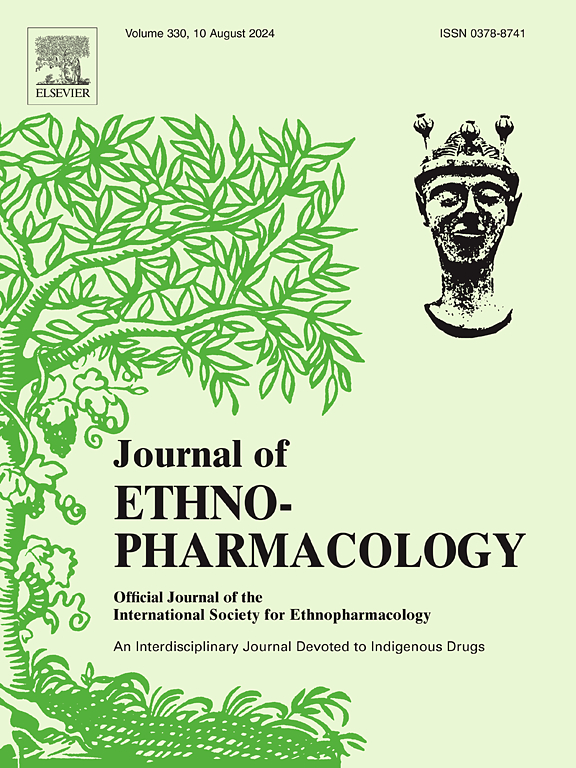Benincasae Exocarpium对高尿酸血症大鼠的抗高尿酸、保肝护肾作用
IF 5.4
2区 医学
Q1 CHEMISTRY, MEDICINAL
引用次数: 0
摘要
benincasae Exocarpium (BE)是草本植物Benincasa hispida Cogn.的外皮。属于葫芦科。BE具有解渴、利尿、祛湿、清心火的功效,在医学上有着悠久的应用历史,这表明它有可能干预高尿酸血症(HUA)。本研究旨在阐明BE对HUA大鼠的抗HUA作用,特别是其对肝肾损害的保护作用。材料与方法采用suplc -MS/MS分析鉴定BE的成分,用氧酸钾和次黄嘌呤建立HUA大鼠,对BE处理的HUA大鼠进行肝脏和肾脏的生化参数和转录组学分析,并通过Western Blot进一步验证。结果BE主要由氨基酸、黄酮类、生物碱和萜类组成,体外对黄嘌呤氧化酶(XOD, IC50 = 720.6 μg/mL)具有中等抑制作用,体内可降低血清尿酸(UA)、TC、TG、IL-1β、IL-6和TNF-α水平,降低AST、CRE和BUN水平,支持BE改善HUA大鼠肝肾功能的作用。此外,BE通过调节肝脏XOD和肾脏URAT1、GLUT9、ABCG2和OAT1的表达,抑制UA合成,促进UA排泄。此外,结合转录组学和Western Blot分析的验证实验证实,BE通过TLR4/NF-κB/NLRP3信号通路调节hua诱导的肾脏炎症和肾小球肿胀。值得注意的是,肝脏转录组分析和进一步的分子数据表明,BE通过调节IRS2/FoxO1/AMPK/ACC信号通路减轻了HUA引起的代谢紊乱。结论综上所述,BE主要促进UA排泄,并能有效减少UA的重吸收和抑制UA的产生。值得注意的是,BE对HUA大鼠的肝、肾具有保护作用,可减轻肾小球肿胀,减轻肝脏代谢紊乱。因此,BE可以作为具有抗hua特性的膳食补充剂。本文章由计算机程序翻译,如有差异,请以英文原文为准。

Antihyperuricemic, hepatoprotective and nephroprotective roles of Benincasae Exocarpium in hyperuricemia rats
Ethnopharmacological relevance
Benincasae Exocarpium (BE) is the outer peel of the herbaceous plant Benincasa hispida Cogn., belonging to the Cucurbitaceae family. BE has a long-standing history in medicinal applications for its capabilities to relieve thirst, promote diuresis, eliminate dampness, and clear heart fire, which suggest its potential for the intervention of hyperuricemia (HUA).
Aim of the study
This study aimed to clarify how BE exerts its anti-HUA effect in HUA rats, especially its protective function on liver and kidney damage.
Materials and methods
UPLC-MS/MS analysis was employed to identify the components of BE, HUA rats were established by potassium oxonate and hypoxanthine, and the biochemical parameters and transcriptomics analyses of liver and kidney in BE-treated HUA rats were carried out with further verification by Western Blot.
Results
BE mainly consisted of amino acids, flavonoids, alkaloids, and terpenoids with a moderate inhibitory effect on xanthine oxidase (XOD, IC50 = 720.6 μg/mL) in vitro and reduced serum levels of uric acid (UA), TC, TG, IL-1β, IL-6 and TNF-α, as well as lowered AST, CRE, and BUN levels in vivo, which supported the efficacy of BE in improving liver and kidney function in HUA rats. In addition, BE inhibited UA synthesis and facilitated UA excretion by regulating the expressions of XOD in liver and URAT1, GLUT9, ABCG2 and OAT1 in kidney. Moreover, BE regulated HUA-induced renal inflammation and glomerular swelling through TLR4/NF-κB/NLRP3 signaling pathway, as evidenced by validation experiments combining transcriptomics with Western Blot analysis. Notably, liver transcriptome analysis and further molecular data indicated that BE alleviated metabolic disorders caused by HUA through regulation of IRS2/FoxO1/AMPK/ACC signaling pathway.
Conclusions
Above results suggest that BE primarily promotes UA excretion and is effective in both reducing UA reabsorption and inhibiting UA production. Notably, BE exerts protective effect on liver and kidney of HUA rats by reducing glomerular swelling and alleviating hepatic metabolic disorders. Therefore, BE can act as a dietary supplement with anti-HUA property.
求助全文
通过发布文献求助,成功后即可免费获取论文全文。
去求助
来源期刊

Journal of ethnopharmacology
医学-全科医学与补充医学
CiteScore
10.30
自引率
5.60%
发文量
967
审稿时长
77 days
期刊介绍:
The Journal of Ethnopharmacology is dedicated to the exchange of information and understandings about people''s use of plants, fungi, animals, microorganisms and minerals and their biological and pharmacological effects based on the principles established through international conventions. Early people confronted with illness and disease, discovered a wealth of useful therapeutic agents in the plant and animal kingdoms. The empirical knowledge of these medicinal substances and their toxic potential was passed on by oral tradition and sometimes recorded in herbals and other texts on materia medica. Many valuable drugs of today (e.g., atropine, ephedrine, tubocurarine, digoxin, reserpine) came into use through the study of indigenous remedies. Chemists continue to use plant-derived drugs (e.g., morphine, taxol, physostigmine, quinidine, emetine) as prototypes in their attempts to develop more effective and less toxic medicinals.
 求助内容:
求助内容: 应助结果提醒方式:
应助结果提醒方式:


